
 |
Eager Space | Videos | All Video Text | Support | Community | About |
|---|


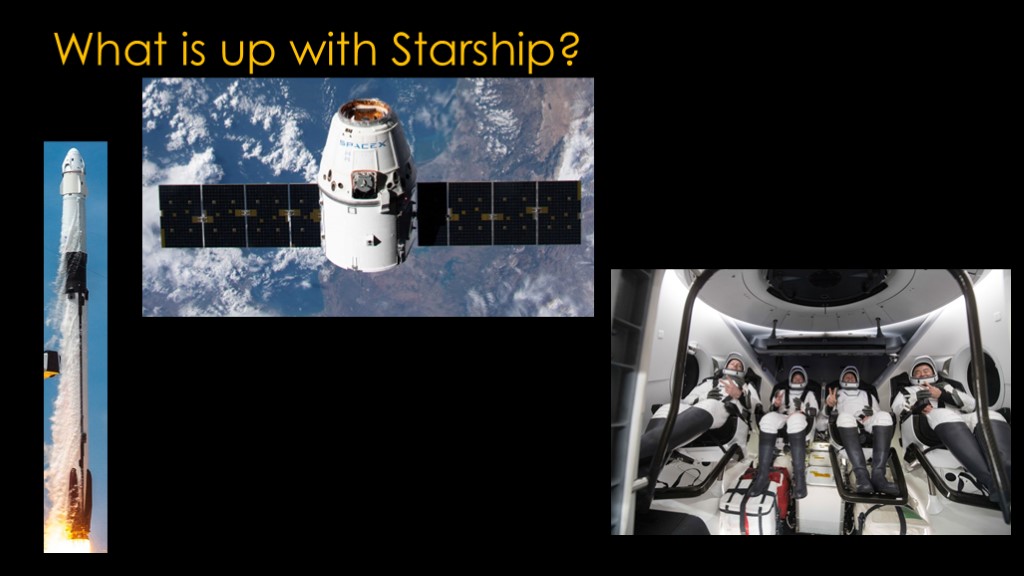
What, exactly, is up with Starship?
Why is a company that has done so well with Falcon 9 and both cargo and crew dragon having so much trouble with starship?

We got Starhopper in 2019 and then in 2020 a series of tank tests, and then in late 2021 we had a great series of high flight and landing tests, culminating in the successful flight of SN15.
And then lots of activity and talk about flights for a couple of years, but it wasn't until April of 2023 that we got to IFT-1, the first test flight, which tore up the launchpad, had significant engine problems, didn't make it to staging, and couldn't even blow itself up properly.
It was a bit of a fiasco.
IFT-2 in November was a bit better - it got through separation and was able to blow itself up.
IFT-3 in March made more progress, with the booster making its way back towards the launch pad and the ship making its way on its trajectory though both went out of control.
Progress, but this was coming from SpaceX, the company that developed booster landing and is launching far more Falcon 9s than the rest of the world is launching rockets.
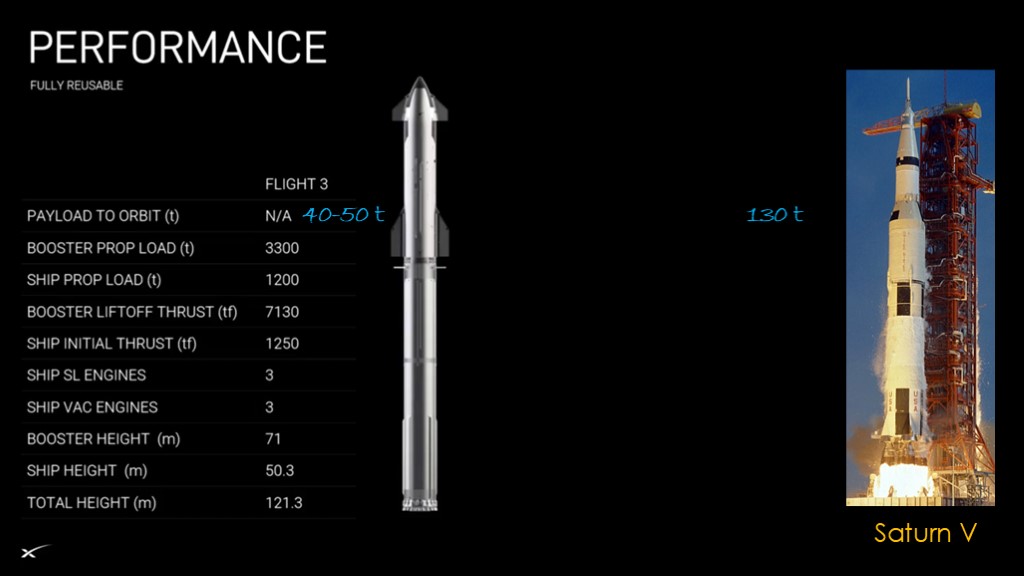
The final straw was this chart that Elon presented in an employee update after IFT-3 where it was disclosed that the current starship didn't really have a specified payload, but Musk said that it was about 40-50 tons in the current configuration.
That's a far cry from the 150 tons that is commonly talked about, and a lot worse than the Saturn V, a smaller rocket.
How is this not a failure?
Now that I've pushed you out on the ledge, let's see if I can talk you down.
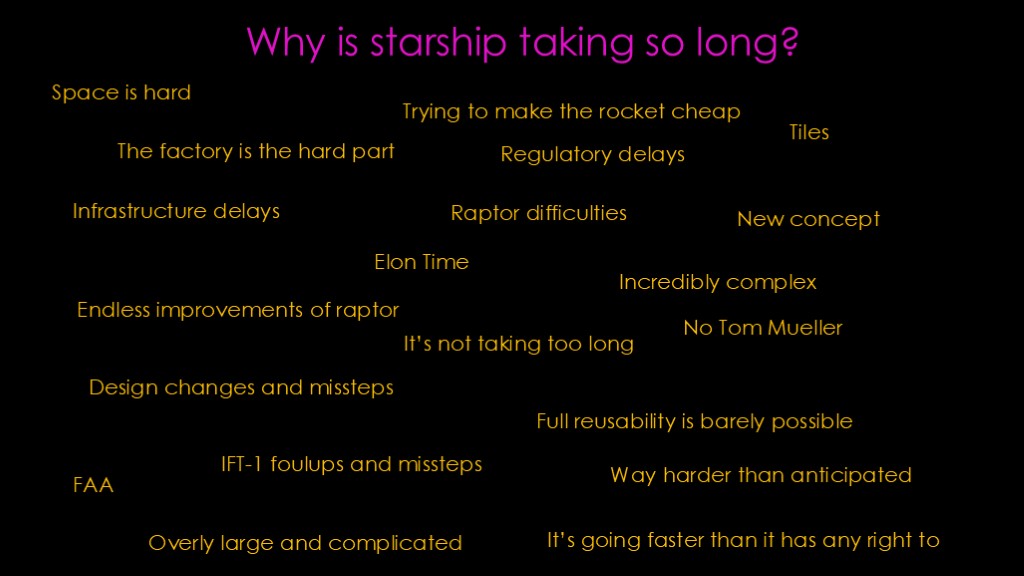
I asked my TwiX followers why they thought starship was late, and got a bunch of different responses that I'll paraphrase here.
(add them here)
Many of these responses align to what I used to think.
But there were a few responses that gave what I now believe is the best explanation.
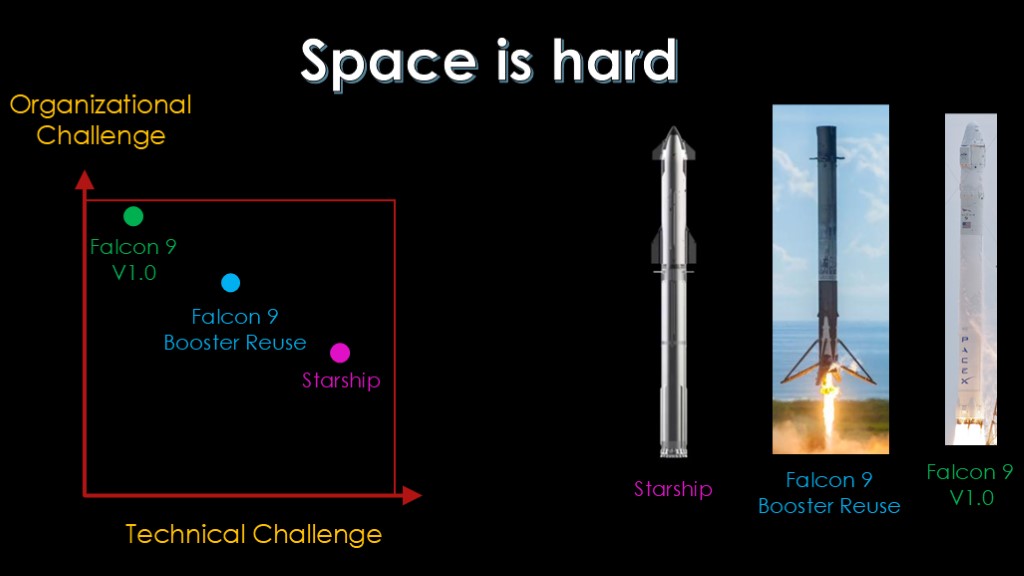
We've all heard the simple saying that space is hard. It has quite a bit of truth in it, but it tends to mush together things that have high technical challenge with those that are hard just because an organization is inexperienced.
Falcon 9 version 1 was hard for SpaceX because they had never built a rocket that big, but it was a boring rocket design with a boring engine, and that was one of the keys to their success.
Falcon 9 booster reuse was technically challenging because it was this brand new thing, but it wasn't as hard from an organizational perspective because SpaceX had a good handle on Falcon 9 in general and they could work on it incrementally.
Then starship comes along, and it feels like it's harder than booster reuse but not that much harder - at least that's where I put it in my mind. And that seemed to be reinforced by the early starship flight tests - they felt a lot like the Falcon 9 booster reuse tests. They had an design, flew it, and iterated until they had it working. Starship would need to nail reentry but shuttle had done that 40 years ago. And this was SpaceX, who made Falcon 9 and capsules look easy.
It turns out that I was wrong. Quite wrong.
Starship belongs over here. It is quite literally "off the charts" in terms of the technical difficulty, and once I realized that, there were a number of things about starship that had always confused me that suddenly made sense.
But I'm getting ahead of myself. We need to talk about the physics first.
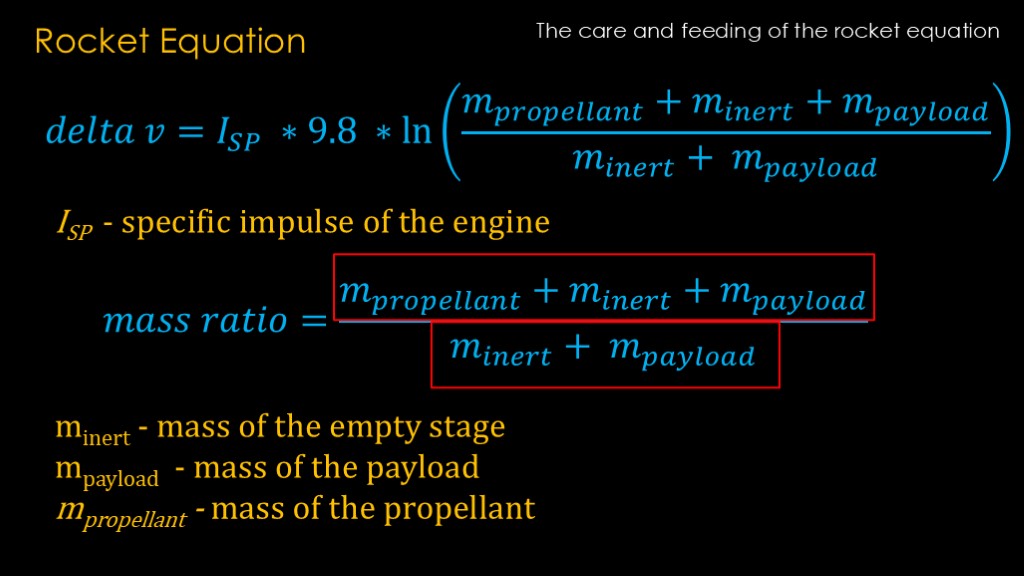
We'll start with our old friend, the rocket equation.
If you want the whole story, see my video "the care and feeding of the rocket equation".
What we are calculating is the delta v that we can get out of specific stage with a given payload. If you think of delta v as a measurement of how far you can go, you'll have the right idea.
It's actually fairly simple. The ability to send payload to a given destination depends on how good your engine is, how light your rocket stage is, and how much propellant you can stuff into it.
Isp is the specific impulse of the engine, which is a measure of fuel efficiency. That is set by the propellant that you use - liquid hydrogen, liquid methane, and RP-1 kerosene all have different specific impulse profiles - and by the kind of engine that you have. If you want a higher specific impulse out of a given fuel, you will need an engine design that can accomplish that. More on that later.
The fraction inside the natural log is known as the mass ratio. The denominator is the mass of the empty stage plus the payload - it's the mass that is leftover when all the propellant is burned.
The numerator is that same mass plus the mass of the propellant.
If we can put more propellant in a stage we get a better mass ratio and can do more. If we can reduce the inert mass or fly with a smaller payload, we get a better mass ratio and can do more. If you want to know why the natural log is there, the answer is "because math" or "because physics". Go watch the video I linked to.
For Starship, we already know what engine and fuel we are using, so the specific impulse is pretty much a constant. Changes in engine design might move it a little, but not a lot.
The mass ratio therefore matters a lot.
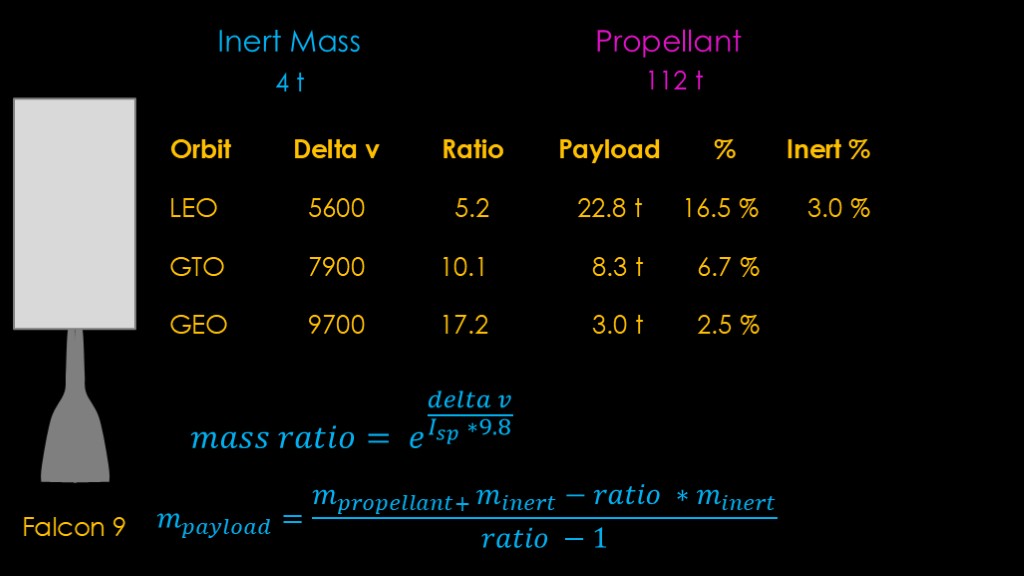
Let's look at an example. I'm going to use Falcon 9 in fully expendable mode because there are good numbers there, and we're going to only look at the second stage. We know that the empty mass of the stage is 4 tons and it holds 112 tons of propellant.
Let's say that we are trying to launch a payload to low earth orbit. That will take about 9400 meters per second of delta v total and for the Falcon 9, about 5600 meters per second of that needs to come from the second stage. We can run the rocket equation backwards and we'll find that we need a mass ratio of 5.2.
We can then plug the ratio into the bottom equation - which tells us how much payload we get from a given ratio - and we get the expected 22.8 tons. The payload to low earth orbit is about 16.5 % of the total second stage mass, which is good performance. The inert mass is only 3% of the total.
Now we can try a harder destination...
Flying a payload to geosynchronous transfer orbit requires about 11,800 meters per second of delta v, and 7900 meters per second needs to come from the second stage. To achieve that, the ratio goes all the way up to 10.1. The only thing we can change is the payload, and to get that ratio, we have to reduce it all the way down to 8.3 tons. The payload percentage drops to 6.7% and notice that we took a 64% payload hit to only increase our delta v by 41%. The relationship between delta v and payload is not linear.
Flying all the way to geostationary orbit requires 13,600 meters per second of delta V, and the second stage needs to provide 9700 meters per second. That pushes the ratio up to 17.2 and the payload down to 3 tons, or 2.5%
Looking at those numbers, we can see that GEO only requires about 75% more delta-v, but the ratio has to go up by 230%, and the payload is cut by down to only 13 %. That is the way the rocket equation works; adding delta v is hard.
The falcon 9 second stage is very good; it is light and it can carry a lot of propellant.

It might make more sense with a graph.
This is a graph of the payload at different delta v values for the full Falcon 9 vehicle.
On the left we have the expendable payload of 22.8 tons to LEO. If we go with drone ship recovery, the delta v required goes from 9400 to 10,055 meters per second, and that drops the payload down to about 16.8 tons. And then a return to launch site requires about 10,700 meters per second of delta V and therefore can support only 13 tons of payload.
The line is pretty flat because the second stage is so light and the payload fraction is so high.
Now let's look at starship
Reference:
(Starship Orbital Delta v spreadsheet)
Falcon 9 - 2.6 kg reduction in payload for every m/s in additional delta v. 0.01%
Starship - 50 kg reduction in payload for every m/s of additional delta v. 0.1%
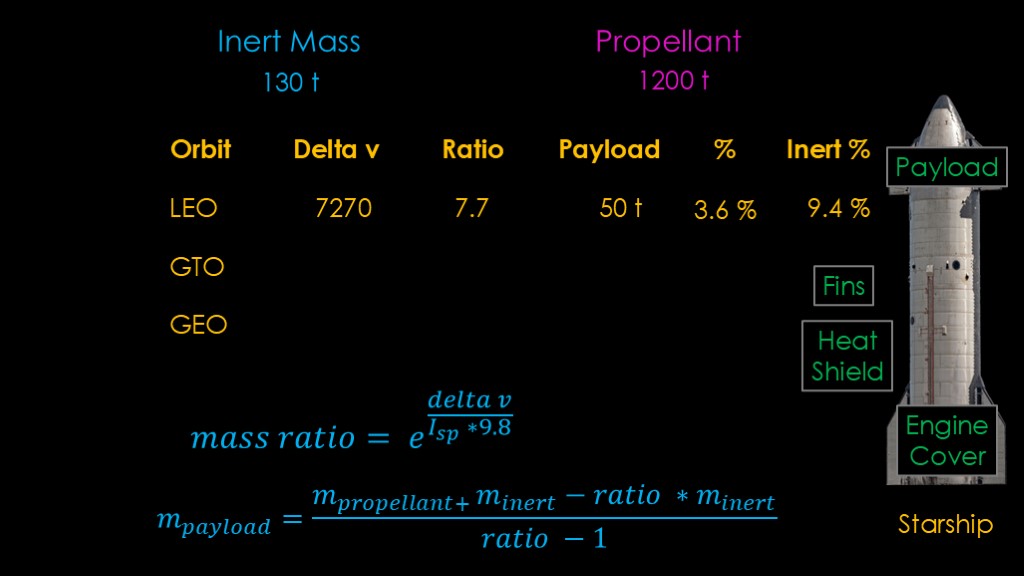
Starship is very different. Based on some reasonably decent numbers, it has an empty mass of 130 tons and a propellant mass of 1200 tons. Because it is fully reusable, it needs to devote delta v to getting the first stage back to the launch site and to the reentry and landing of starship.
That's a pretty big tax; my numbers suggest it's around 11,000 meters per second in total, and 7270 meters per second from starship. That gives a mass ratio of 7.7 and a payload of 50 tons. That 50 tons is only 3.6 % of the second stage mass.
The problem is the inert mass. Starship has a full payload section, a tail section to cover the engines, fins to control it during reentry, and a heat shield to cover all of the bottom so that it will survive reentry. That inert mass is about 9.4% of the full stage mass.
As for GTO and GEO orbits, you can forget about them. You may have heard me state that starship could send 20 tons to GTO. Not with this starship, and maybe not even with future ones.
It's a little clearer if we look at a visual representation.
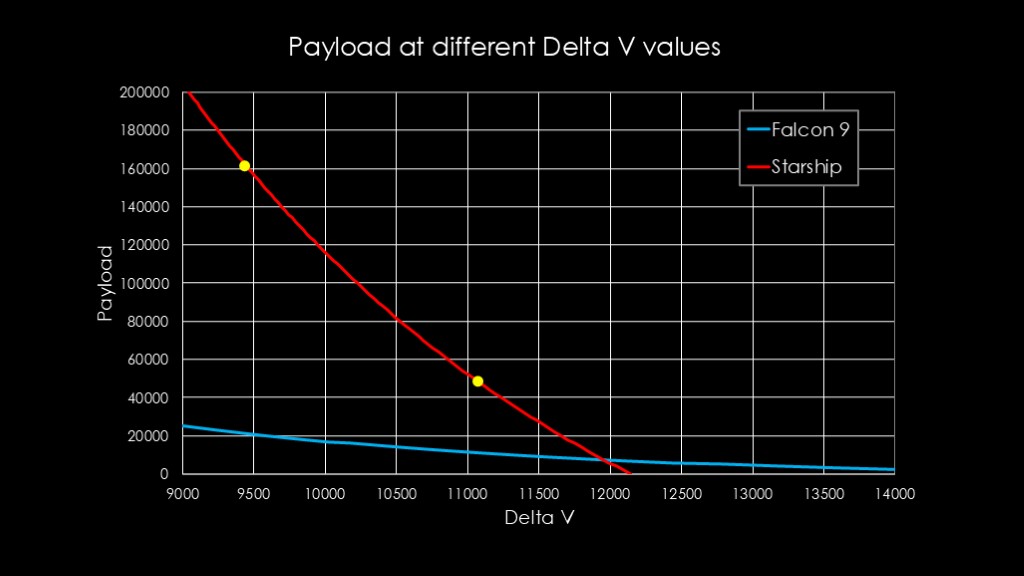
It looks like this, with the 50 ton payload highlighted. Starship is hugely sensitive to changes in delta v because of the poor inert weight, but that inert weight is what you are stuck with if you want a fully reusable second stage.
I first did a chart like this for the video on starship and heavy gravity, and I'm a bit embarrassed to admit that I never did a chart like this before, because it makes so many things make sense. The combination of the high required delta v and the mass cost of reuse just make it ridiculously hard to do full reuse, and that is what is has been driving starship all along.
Musk often gets accused of overhyping things, and there's some truth there. But this is a case where he has been seriously underhyping the true difficulty of what starship is trying to do.
Before we move on, I want to add this little data point at 9400 meters per second of delta V, which shows us that the 50 ton reusable starship can carry 160 tons to low earth orbit if it flies in fully expendable mode. And that's carrying around the reusable fins and heat shield; if you remove those the mass ratio will improve a lot and it's probably closer to 200 tons.
Once internalized what this graph meant, a few things made sense.
Reference:
(Starship Orbital Delta v spreadsheet)
Falcon 9 - 2.6 kg reduction in payload for every m/s in additional delta v. 0.01%
Starship - 50 kg reduction in payload for every m/s of additional delta v. 0.1%
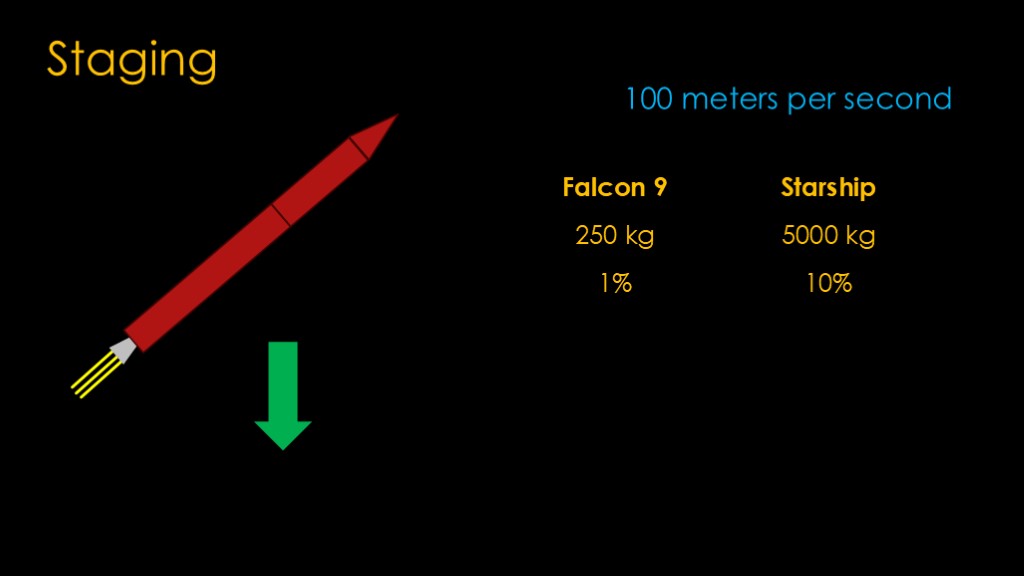
Staging on Falcon 9 is inherently a wasteful process.
The first stage is thrusting hard, and then it hits MECO and shuts off all of its engines. At that point the big force acting on the rocket is gravity, pulling it back towards the earth every second.
Then there is a pause, and the second stage separates, and after it gets far enough away to be safe, the second stage engine starts and the second stage continues merrily on its way to orbit.
If it takes 10 seconds, the gravity loss is probably on the order of 100-120 meters per second of delta v. On the Falcon 9, that probably costs around 250 kg of payload - or only around 1% - because the payload to delta v graph is so flat.
The same loss on starship is worth about 5000 kg, or about 10% of the payload, because the payload to delta v graph is much steeper.

There's also the problem of the first stage, especially for return to launch site reuse. After separation, the booster is pointing in the wrong direction and you need to spin it around so it's pointing in the right direction before you relight the engines. Not only is it falling towards earth during that time, it's getting farther away from the launch site.
Both of those mean that the booster needs to use more fuel to get back to the launch site, and that's fuel that it can't use to give more energy to the second stage.
It's not a big deal for Falcon 9 because the graph is flat and also because Falcon 9 only flies return to launch site when it has very light payloads and delta v isn't very important with a light payload.
Falcon 9 can afford the casual staging approach, but Starship can't.

Which is of course why they have gone with hot staging.
My initial thought was that this was just an optimization they did because they were trying to get things right from the start, but since I've seen the delta v payload chart I realized that SpaceX is fighting for every little improvement they can find just to make full reuse *possible*.
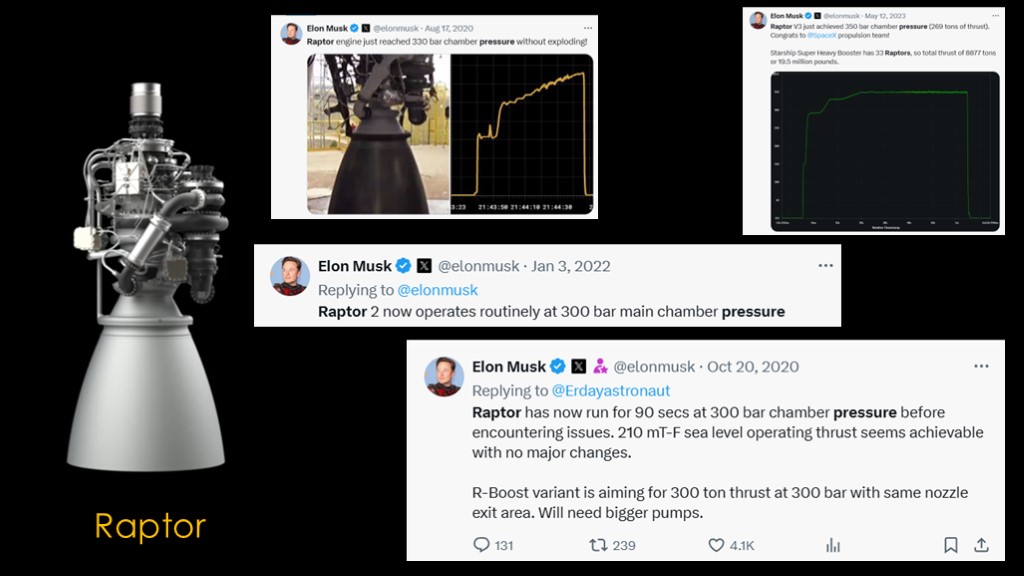
Which brings up to Raptor, and what I used to think was the most confusing part of Starship.
Musk tweeted about it all the time. In fact, it seemed like he might be obsessed with it.
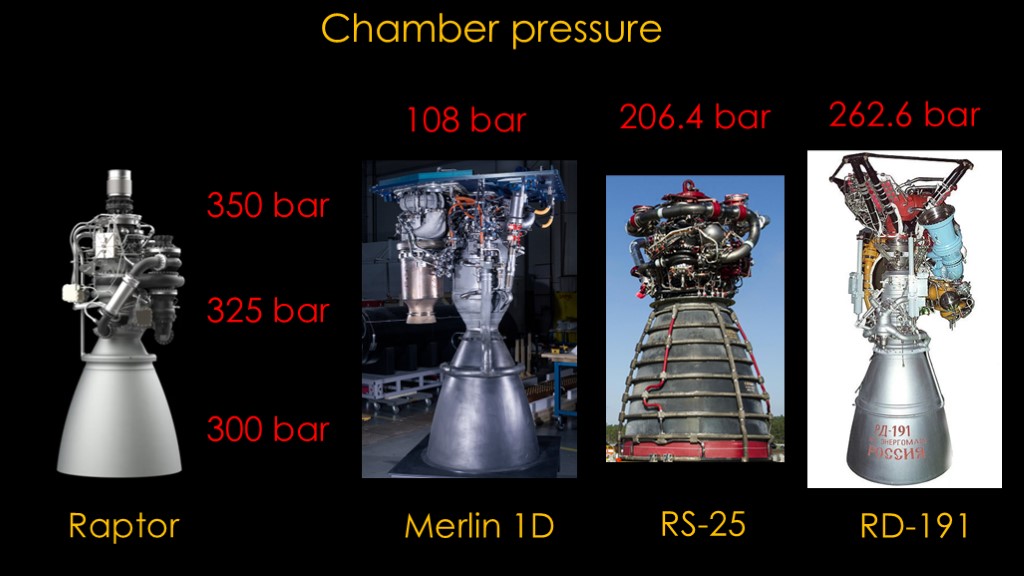
The obsession seems to be about chamber pressure.
The record chamber pressure for a rocket engine was the Russian RD-191 engine, which ran at 263 bar, or about 3800 pounds per square inch, which is very high. The RS-25 space shuttle main engine was the current US title holder at 206.4 bar, and the Merlin 1D flown on the Falcon 9 came in a very conservative 108.
Raptor 1 was testing at 300 bar in 2018, Raptor 2 is likely capable of around 325 bar, and Raptor 3 has a goal of 350 bar.
All of these are far larger than the RD-191, and developing such high chamber pressure engines is very difficult and therefore expensive in both money and time.
Why didn't SpaceX stick with the "tame" 300 bar engine and save the other versions for later?
The answer is simple. The Raptor 1 engine that powered IFT-1 has a payload to orbit of pretty close to 0kg.
That is a fairly astonishing result. The lower thrust of the raptor 1 means that you have to reduce the propellant you carry to get the same thrust to mass ratio, and the lower propellant load reduces the stage mass ratio and therefore reduces the delta v you can create.
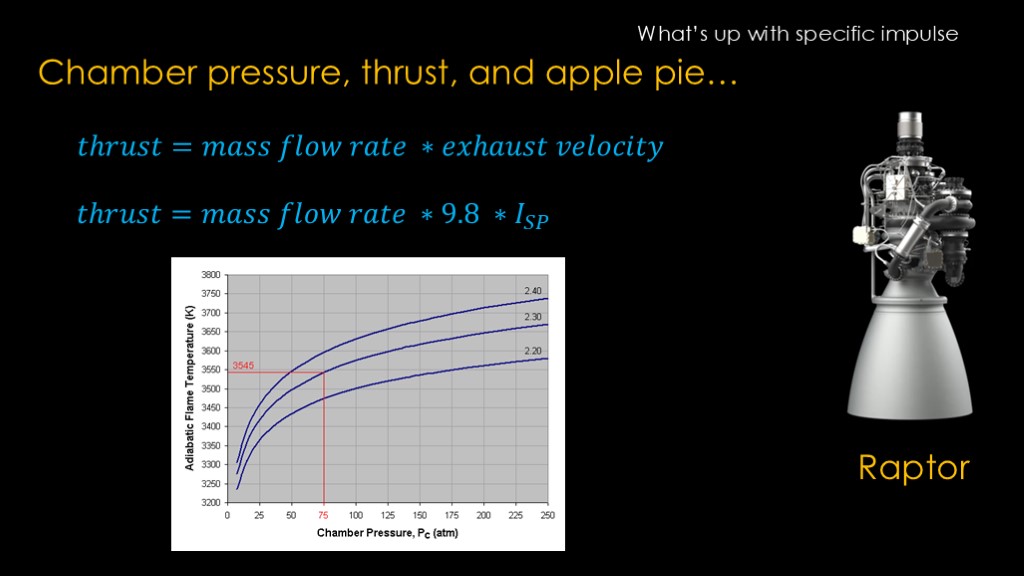
We want high thrust so that we can lift more propellant. That's why Super Heavy has a ridiculous number of engines.
The equation for thrust is simple - it's the amount of mass that flows into the combustion chamber multiplied by the exhaust velocity. We would generally write that using 9.8 times the specific impulse.
So if we want to build a higher thrust engine, we need to either increase the mass flow rate or we need to increase the specific impulse. If we increase the pressure feeding into the combustion chamber, that gives us a higher chamber pressure and increases both the mass flow rate and the specific impulse.
A higher chamber pressure burns hotter, which gives the exhaust particles more energy and therefore a higher exhaust velocity and higher specific impulse. But as you can see with this graph, it gets pretty flat at high chamber pressures, so the specific impulse gains are fairly small.
We also can open up the size of the combustion chamber throat a bit; that makes it easier for the exhaust to escape and increases the mass flow rate, but by itself it will reduce the chamber pressure. Or you can do both.
SpaceX continues to push for more chamber pressure and thrust because that will improve the delta v capability of the rocket. Every rocket designer always wants more thrust.
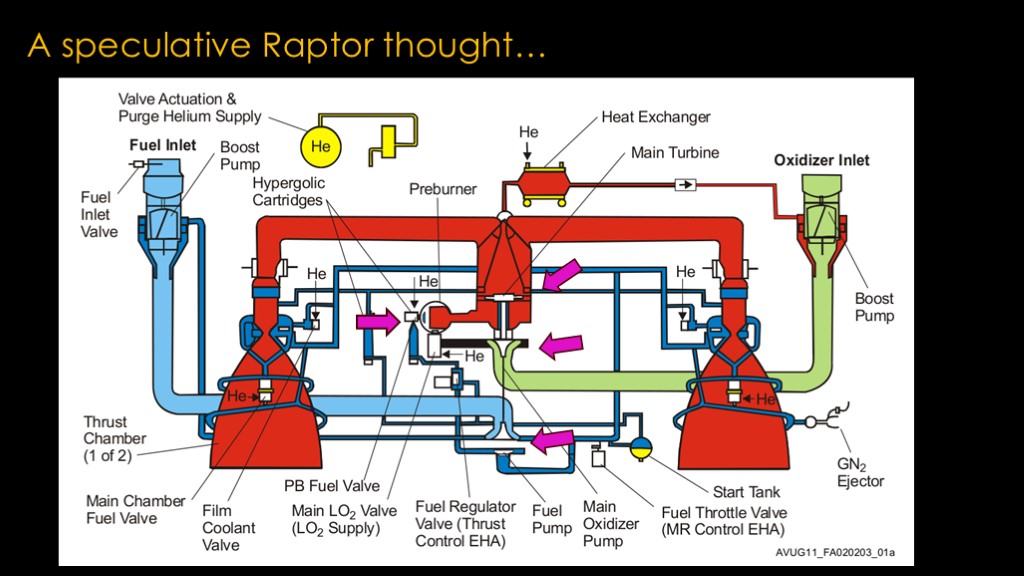
I had a thought about the raptor design and while I don't know whether it's true or not, it's an interesting thing to think about.
In an engine like the RD-180, some of the RP-1 kerosene is burned with liquid oxygen in the preburner, and that drives the main turbine to produce the power to pump the propellants. Both the RP-1 fuel and liquid oxygen pumps are driven with that same turbine, and that means that the ratio between those two propellants is fixed.
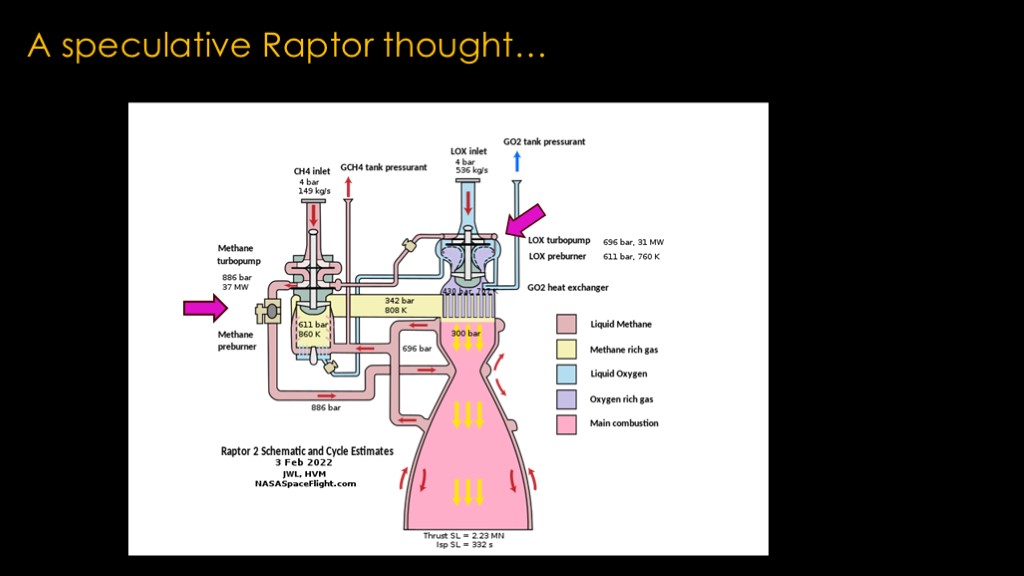
The full-flow staged combustion design that raptor uses has separate liquid oxygen and liquid methane preburners and turbopumps, and that gives them the opportunity to vary the mixture ratio between the two propellants on the fly.
Rockets generally fly fuel rich so that there isn't any hot free oxygen in the exhaust and they generally use a fixed ratio. Raptor supposedly runs at a ratio of 3.6:1 for oxygen and methane, but with the full-flow setup SpaceX can easily experiment with different ratios including the hotter ratios that are closer to 4:1. They could even vary the ratio during flight.
I have no idea how much they are doing with this, but it seems possible.
Note that the RS-25 space shuttle main engine also had two preburners so it theoretically could have done this but AFAICT, they always ran at a fixed ratio.
I now understand why SpaceX has been so focused on raptor performance and why they decided to do hot staging. It's the only way to get the performance they need.
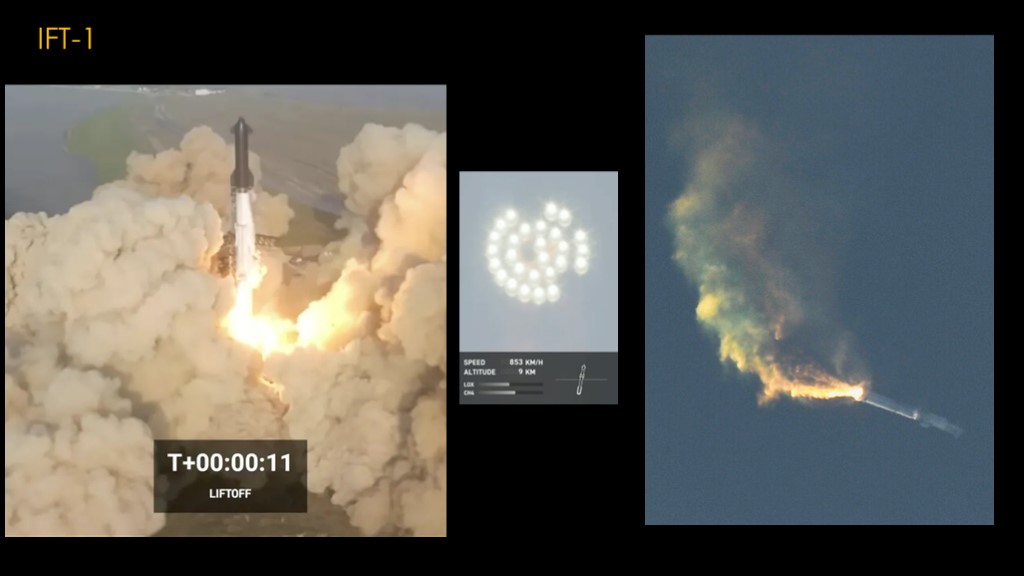
One more weird thing about Starship that makes more sense now...
Remember IFT-1 and how much of a fiasco it seemed to be, with a severely damaged launch pad area, multiple engine failures, and flight control issues. At the time, this didn't seem like a SpaceX thing to do, to launch a vehicle that was so flawed and to have delays fixing the launch pad issue.
At the time, Elon estimated a 50% chance of success and said that if the rocket got far enough away from the launch pad before something goes wrong, that he would consider the test to be a success.
Which seemed like a really low bar at the time.
What we didn't know is that the IFT-1 flight wasn't their first prototype flight because to actually fly the first flight the way they wanted to, they needed the additional performance of raptor 2 in a vehicle designed for it.
So they chose to launch a vehicle that they knew was going to have issues to see what they could learn from it. It was either to launch that vehicle or just scrap it. And that's why they seemed to be so unconcerned about the issues on the flight.
Knowing that, I would argue that IFT-1 was a very SpaceX thing to do. Though I don't think they counted on how much reaction the launch pad concrete issues would bring.
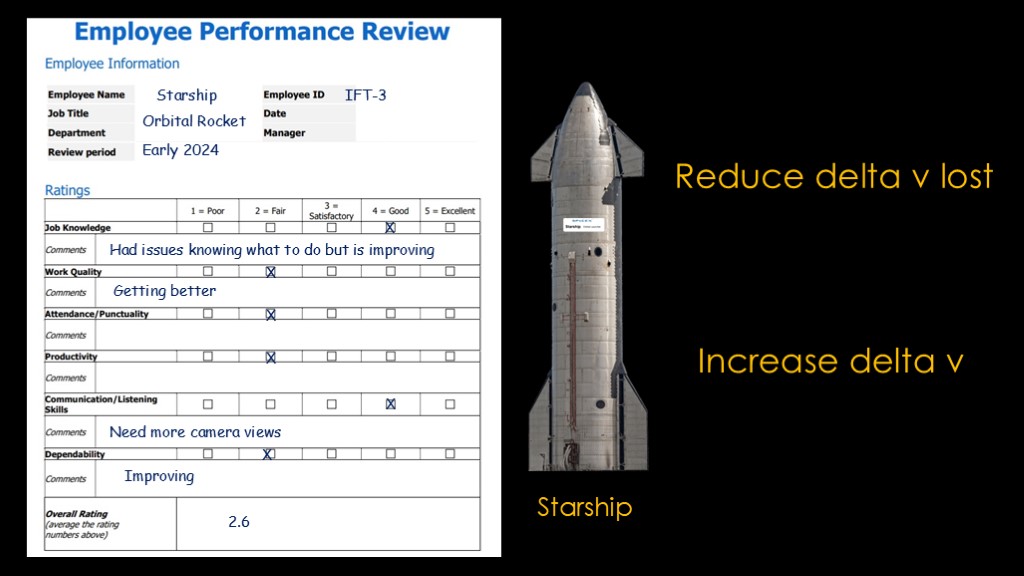
However, even with all that work, the current version of Starship has a performance problem. It needs to carry more payload.
There are two things to do...
Reduce the delta v losses during launch.
Increase the delta v available from the vehicle by improving the specific impulse or the mass ratio.
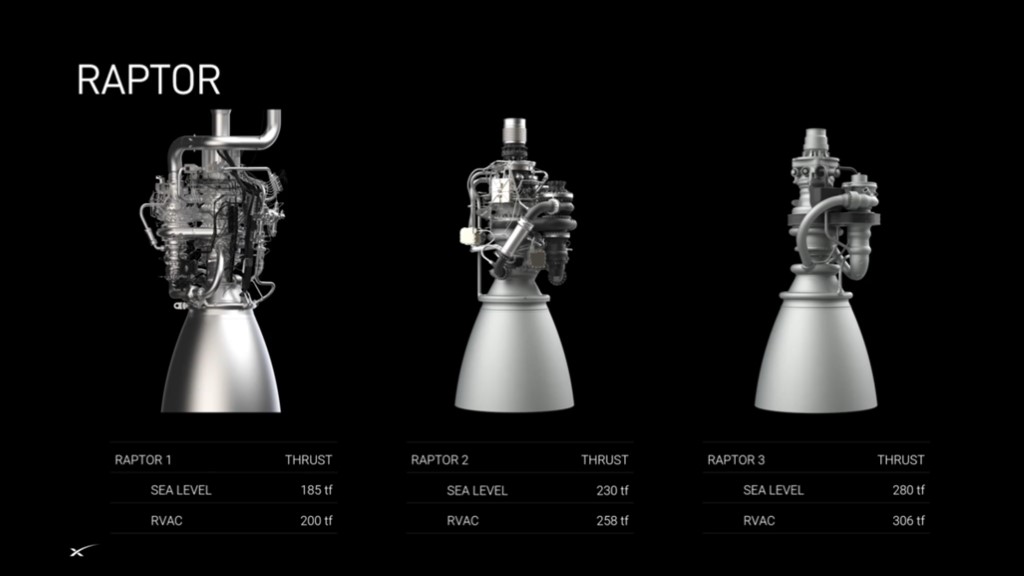
The first is further improvements to raptor. Raptor three will push the thrust up another 20% - allowing the same number of engines to lift more propellant and increase the mass ratio and therefore the delta v and therefore the payload.
They are also continuing the simplification that they started on raptor 2; they are routing the extra plumbing they need internally in the parts. Nobody has done that before and it will be a lot of work, but the hope is that it will allow them to both reduce the mass of the engine itself and eliminate the heat shielding the engines currently wear. That will reduce the inert mass and improve the mass ratio.
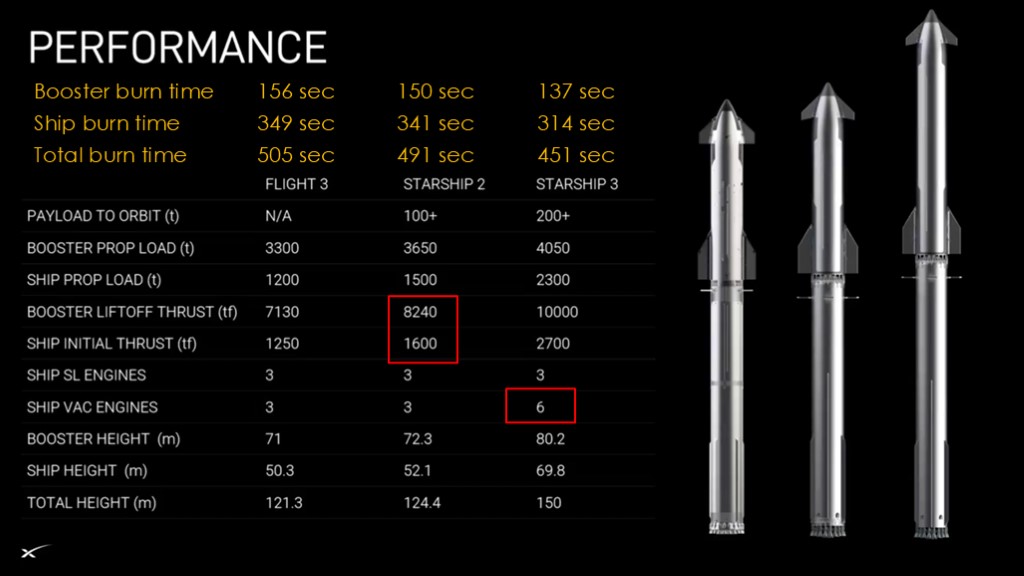
Elon showed this chart in the employee update after the IFT-3 flight.
Based on engine thrust improvements, starship version 2 will get a bit taller in both the ship and the booster to carry more propellant and that will increase the mass ratio enough to put it about 100 tons of payload. It won't take a lot because the line on the graph is so steep.
I consider starship 3 to still be speculative based on Musk's comments. The big change there is going to 6 vacuum engines on the ship to give it much higher thrust and therefore a big bump in propellant and delta-v, and then a small increase in the booster to help it carry the much heavier ship. This depends on further engine thrust improvements; if those aren't there I'd expect to see a bigger ship than starship 2 but not as big as starship 3.
There's another small optimization going on here that isn't obvious. We can figure out how many of seconds of propellant the booster and ship carry, and for flight 3 we get 505 seconds. Note that some of the booster fuel goes to boostback and landing and some of the ship fuel also goes for landing, and also note that they don't fly full throttle the whole time, so this number is wrong in actuality but okay for comparison.
For starship 2, the higher thrust means that they burn the fuel faster and even with bigger tanks, the total burn time is less. This means they get into orbit more quickly and *that* means that they waste less energy on gravity losses.
For starship 3, it's even more profound because of the addition of three more engines to starship means starship will really fly. They will likely have to throttle down - or perhaps shut down some engines - more on starship 3 as it gets lighter near the end of its flight, so the improvement won't be as big as these numbers indicate.
You can also think of this in terms of thrust to mass ratios; better thrust to mass ratios means you get into orbit more quickly and spend less time fighting gravity.

What did I learn about Starship?
It is hard to overestimate how hard it is to build a reusable second stage. They need to be robust enough to survive reentry and light enough to carry a useful payload.

Landing the booster at the launch site makes it harder. There's a non-trivial cost to doing that.

Even small optimizations help. Approaches like hot staging help.
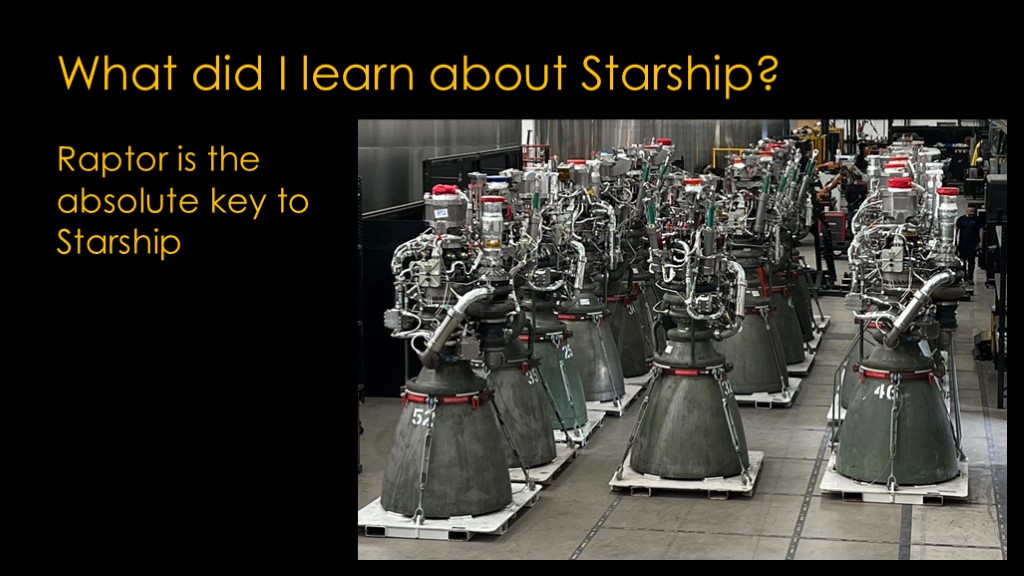
And, most important, Raptor is the absolute key to starship. There may be other fully-reusable approaches that might work with a tamer engine, but for the starship architecture you need an absolute screamer of an engine.
Musk is obsessed with Raptor not because it's a cool engine, not because SpaceX is showing off, but because without a ridiculous level of performance out of Raptor, Starship cannot reach its goals.
And that's why Starship is late, or at least why there was such a big gap before they flew a real prototype. Its goal is ridiculously hard and it takes incredibly good engineering to make it possible.
The good news about this is that SpaceX finally has an engine that is good enough for Starship, and that's why they have made so much progress in IFT-2, 3, and 4.
We are back to the SpaceX we expect, and I am less confused. Which is nice.

If you enjoyed this video, please send me this wonderful poster from despair.com